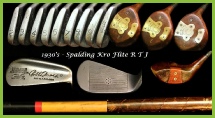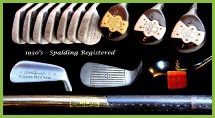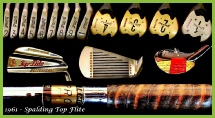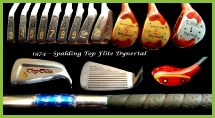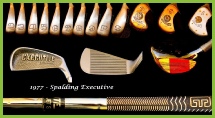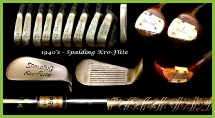
The Early Years
Starting in 1900, Spalding opened clubmaking factories in London and in Fife, Scotland, producing forged iron heads for Spalding clubs sold both in the UK and U.S. Irons made during that time are distinguished by an anvil cleek mark. The company's unique "baseball mark"-- A.G. Spalding had helped put baseball on the map--was stamped on the clubs and below it "Made in Great Britain" appeared. Throughout America, the affordable Spalding clubs flew off the shelves and reaped huge catalogue sales.
Innovation
Spalding introduced many variations of hickory-shafted clubs to bring distance and control to the professional and duffer alike. The company was selling aluminium fairway clubs by 1910, and its Gold Medal series (1910 to 1919) featured aluminium bronze. Spalding's lead-faced putters also provided better touch for players. One of the most famous Spalding clubs was the Cran Cleek (club with a narrow face and little loft) for poor fairway lies and even putts. Today, collectors prize the narrow-faced Cran Cleek.
Deep Grooved and Drop Forged
Golfers have always known that deep-grooved irons produce better control and spin.
Spalding led the way with such deep-grooved designs as the "waterfall" and waffle-face
irons.
Until the USGA banned deep-grooved irons, Spalding's Stop 'Em and Dedstop
clubs brought a smile to countless players' faces.
By the Roaring 20’s, A.G. Spalding
& Brothers was using the process of "drop forging" to manufacture metal club heads.
Club maker’s traditional method had been to shape metal heads with an anvil and forge;
now, like Henry Ford's assembly-line Model T's, Spalding craftsmen used a mechanical
hammer to craft club heads, drill sockets in them to attach the shaft and then polish
the heads, all of which allowed Spalding to manufacture matched sets of clubs and
mass produce them.
State-of-the-Art Shafts
Spalding club maker’s paid as much scrutiny to shafts as to heads. The company experimented throughout the 1920’s and 1930’s with lathe-turned hickory shafts that featured circular ridges spaced at standard intervals down the entire shaft. The design gave the clubs an exotic bamboo look; the underlying message being that these clubs offered players bamboo's legendary flexibility and whip-like strength.
Too Many Choices
With Spalding's mass-market success breeding scores of imitators, players could pick and choose from countless club lines. Golf bags bulged with 20 to 25 clubs, and the USGA, fearing too many specialty clubs had watered down the game's skill levels, took action. In 1938, the USGA passed an edict limiting players to 14 clubs.

